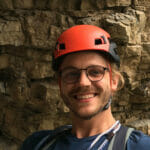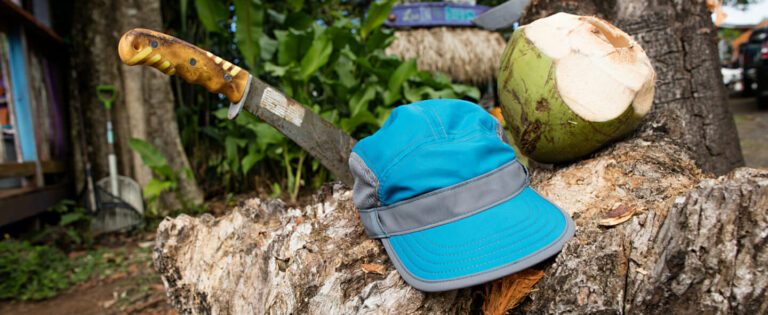“How on earth are you supposed to hold on there?” This is a question I get asked sometimes, and that I ask myself much more often when I’m faced with routes that are clearly beyond my limits. I now know the answer: amongst other things, it comes down to a good deal of finger strength combined with a really good climbing technique.
Without doubt, finger strength counts as one of the most dominant factors in being able to climb really difficult tours. This can also be seen if you take a look at elite climbers. As different as the physical appearance of these “super humans” may be, they all have one thing in common: they can grip quite small holds damned well, and have a lot of experience with this. There is hope for us mere mortals. Even though genetic components play a major role in how strong and susceptible to injury our fingers are, with a little time and patience, they can become really well trained.
Perhaps I shouldn’t begin extra training yet?
Before we get started, a few words for beginners of our great sport. To you I would say that climbing is more than just pure strength. In the first few years, all aspects of climbing can be improved really well just by climbing. Targeted finger training is linked to a high risk of injury for beginners. So instead, it’s better for you to first concentrate on technique, tactics, getting a feel for the movements, your mental capacity, etc.
Sound strength building requires a lot of time
Even if it may seem like the hand ends at the wrist, its extremely complex system extends through many joints right to the shoulder. It’s important to know that the hand’s musculoskeletal system is made up of a large number of complexly interconnected bones, tendons, ligaments and muscles.
The latter gives us the strength to grip small holds. They can be trained easily and make progress quickly. But it’s a different story when it comes to the tendons and ligaments in our hands and forearms. They require higher training stimuli and also a great deal longer to develop the same capacity. Finger tape doesn’t help with this either, only time does!
If we begin finger training at an early stage in our climbing careers, our muscle power develops too quickly and can lead to injuries when climbing. The injury process then happens as follows: the hand and arm muscles are trained and capable of gripping small holds, but the tendons and ligaments in the fingers are not yet tough enough. But with your new strength, you now embark on your long-term goal of finally reaching the top.
But suddenly, at the crux, your foot slips and you absorb the momentum with your upper body. Either you hear a “pop” straight away, and you’ve got acute trauma to one of your annular ligaments, or you repeat this scenario and cause chronic strain. Both cases are typical patterns of injury for climbers and increase the risk of injuring yourself again in the future.
It turns out that you should take a rather conservative approach to the subject of finger strength. Keep in mind that an injury will set you a long way back; the healing process for fingers can take six months or longer.
Reasons to strengthen your fingers
It makes sense that strong fingers can grip smaller holds. But finger strength has an additional benefit. You can hold on for longer. Why? The reason is maximal strength. This is the maximum force that you can initiate in a muscle through purely deliberate effort. Through good training, you can get your discretionary capacity closer to the limits of your emergency power reserves. This means that the muscle cells are supplied for longer and you can stay longer on the wall. Long story short: the stronger your fingers are, the smaller holds can be before the performance of your muscular system is reduced.
Start training right
For finger training to achieve its full effects, you must be well prepared. Part of this is a sufficiently long break between the finger training sessions. It’s recommended that you do finger training a maximum of twice per week. So, between the training sessions, you can take a 48-hour break and you still have time for climbing or bouldering.
On the training days, it’s especially important to do a proper warm up. It’s best to start with exercises such as jumping rope or doing jumping jacks to get your circulation going. Then you can dedicate yourself to your fingers, with repeated hangs on large holds and a little stretching (<10 second strain).
When you are hanging correctly, or training on a fingerboard, you put weight on both your fingers and your shoulders. This is why it’s important to hang onto the board with the right technique. You should therefore consider the following criteria:
- Only hold the training board with an open hand, or with the fingers in half crimp and not supported by the thumbs.
- To stop your shoulders from getting overburdened, it’s important to tense your shoulder muscles. This is especially true for training with added weight!
Through the repeated hangs and stretches, you reduce the risk of injury and increase your capacity for the next training.
It is recommended that the following training programs be followed for four weeks each, and that you take a break for at least a week afterwards. Then you can either use the same programme and increase the intensity, or do one of the other two programmes. Of course, you can also get used to your new strength first and let a few weeks go by without any finger training. We’re not pros, and we don’t have to keep to perfect training regimes.
Training for maximal finger strength – you don’t always have to completely drain yourself
The following training methods are different in terms of length, intensity (hold size/added weight) and rest time. Each variation of these factors has a different training effect on the finger muscles, as well as on the tendons and ligaments.
To train your maximal strength, the training stimulus has to be very high intensity, which means the exercise can only be done for a short time. A longer rest is then necessary so that you can do the next round at full capacity again. After a training session like this, you’ll feel unexpectedly fit. But don’t be fooled, your body has done a lot and needs a break.
With these kinds of training routines, it’s above all your nervous system that gets a workout. The effect is ultimately that your body improves the activation of your muscular system. This can mean that more nerve impulses are sent to your muscular system, more muscle cells are activated at the same time, and more powerful types of muscle fibre are activated earlier. This neuromuscular adjustment is a qualitative feature of the performance capacity of the muscular system, and, in this case, of your grip strength.
Eva Lopez’ minimal board training
Eva Lopez researches training methods for climbing. Based on her studies, she has recommended the following training programme for maximal finger strength. For this, you need a large range of training boards. She uses, for example, the Progression training board. A little less choice isn’t bad, either. From amongst the holds, choose one that you can hang from for just 15 seconds at maximum effort. This is your training hold. It will be your friend for the next 4 weeks.
- 12-second hang
- 3-minute break
- Repeat 4 times
Points 1 to 3 make up a set. After a 5-minute rest, you can do another set. Beginners should leave it at 2 sets. The advanced can do up to 5 sets using different holds.
Advanced climbers (UIAA 8 to 9) and boulderers (Fb 7a) can use this protocol as an introduction to fingerboard training and make significant progress.
Maximum strength training with added weight (after Eric Hörst)
After you have done the first programme over several training cycles, the holds that you can hang from will be very small, and at some point also very painful. Now if not before, it’s come to the time to choose bigger holds in the board again and to increase the training intensity through added weight (an extra 10 to 50 kg). When adding the extra weight, remember that this is supposed to be about sensible training and not about impressing anyone else. First choose a training board that you can hang from with the first phalanx. Add enough weight so that you can hang onto it for just 13 seconds.
Using the board, train with the weight as follows:
- 10-second hang
- 3-minute break
- Repeat 4 times
Then rest for 5 minutes and do another set.
Keep the amount of added weight the same for at least 4 weeks; then you can check if you need to adjust it.
Strength endurance – when “getting drained” works
When you’re climbing, you don’t just want to be able to grip the smallest holds, you also want to get to the top of the route. For this, you need to repeatedly grip onto holds and let them go again. The longer the route, the more often we have to keep gripping. You feel your forearms getting tighter and tighter, and they begin to burn. The following programme will make it easier to tough this phase out.
Intermittent hanging (repeaters)
The Beastmaker (Ned Feehally) may well have made this training programme famous, or at least, I see a lot of people training using the Beastmaker app’s programme/intervals. A lot of people also talk about the good results that they’ve got with this method. Essentially, this programme is really good at training your fingers specifically for climbing, but it’s wrongly labelled finger strength training. Because of the high number of repetitions and the comparatively low intensity, it should be categorised as strength endurance training. This becomes particularly apparent from the physical reaction to the training.
The gripping and releasing corresponds to the pattern when you’re climbing, and “pumps” the forearm. It is precisely this pumping that shows that we’re in the realm of energy production through the “lactic anaerobic system”. This means that the muscle gets its energy primarily from partial glycolysis. It is partial because the energy needs to be available more quickly than the biochemical process can supply it.
This process is not a problem for the body. It just leaves a few things behind, including lactate. This lactate accumulates in the muscle, and can only be broken down again at a particular intensity. As soon as the intensity of the exercise exceeds this threshold, the muscle starts to burn. Above a certain lactate threshold, the muscle will ultimately fail.
Through the following programme, you train strength endurance by improving this break-down process and the muscle’s lactate tolerance. You have two options for doing the programme:
- Option 1: Get yourself a Beastmaker and the app that goes with it (the intervals suggested are quite challenging, so they shouldn’t be integrated into a bouldering or climbing day).
- Option 2: The Eva Lopez method. This can be integrated into a bouldering or climbing day.
For the training, choose a hold that means that you can only just grip it when you get to the last repeater of a set. This means that you need to do a session first to find out the right hold.
- A repeater is a 10-second hang and a 5-second rest
- You do this repeater four or five times in a row
- Then you rest for a minute and repeat these actions three (not too bad) to five times (quite hard), depending on your training level.
Regardless of the training programme, please do remember: tendons and ligaments don’t adapt as quickly as muscles. This means that, when we’re climbing, we have the ability to grip smaller holds, but the load-bearing capacity of the finger is not necessarily guaranteed. This is why you should be particularly careful directly after a finger strength cycle so that you don’t hurt yourself while climbing or bouldering. It’s also important to strengthen the finger flexor muscles’ antagonist muscles. You can find out how this works by reading our article on antagonist training.








